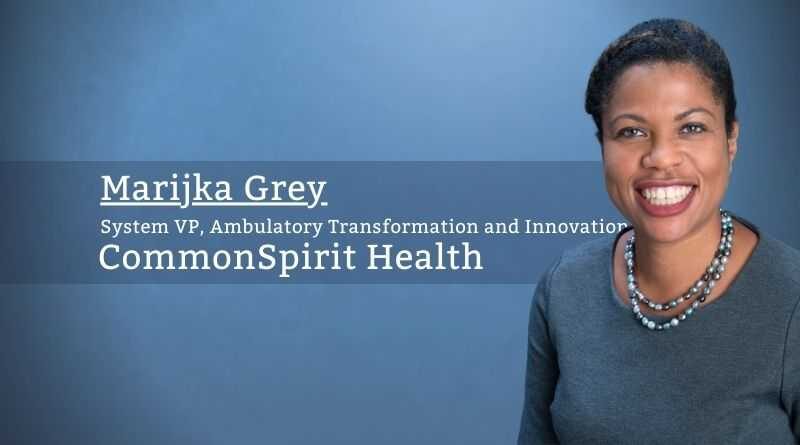The 3 Things Doctors Really Want From Tech
By Marijka Grey, MD, MBA, FACP, System VP, Ambulatory Transformation and Innovation, CommonSpirit Health
Physicians hate change. Physicians hate technology. Although erroneous, these beliefs are pervasive in the tech world: an overwhelming attitude that physicians are technophobes. I’m here to tell you the opposite: physicians love change. We willingly chose a profession where we know that we are standing in a place of ever-changing protocols and procedures. There is always a new medicine, a new device, a new theory of disease and a new pathogen to fight. If there is one single concept that underlies the practice of medicine: it is change.
Physicians also don’t hate technology. We embrace the newest technology in a heartbeat. CT scans instead of X-Rays and then MRIs. Cancer treatment protocols change every few months. We also embrace technology in our personal lives. Many physicians drive the most technologically advanced cars, have the latest gadgets in their homes. The difference is: change in medicine works for our patients; change in technology works for our lives at home and makes it better – change in healthcare technology often does neither.
The ability to understand the fundamentals of the technology and to give critical feedback is a crucial part of enthusiastic physician adoption.
So what do physicians want and need from technology to help them embrace change? I’m here to tell you the top three things that make a difference for your doctors, and by proxy, for their patients.
It Works In Our Ecosystem
Healthcare is complicated. Most health systems have adopted electronic health records, but there are also multiple other systems that clinicians need to interact with. In the hospital – proceduralists often have to log into separate systems. In the ambulatory space, in order to view images or records from other systems, we often have to log out of our primary system and into another source. Every log-in is a challenge to remember the new password, make sure that you have the right security and seldom achieved in 3 clicks or less. Every additional log on is a burden. The question, therefore, to ask about any new technology is – does it work in your ecosystem. Do your providers have to enter a new password and switch back and forth to the product, or is it seamlessly integrated into their day-to-day workflow. Every additional log-in is a barrier to adoption, even if the product has genuinely revolutionary features.
Less Data, More Information
Health care electronic health records (and many products being developed) are data rich, yet information poor. EHRs have made data abundant, but the information actually needed to properly care for a patient is often buried and poorly curated. As we enter into our 40th year of EHRs, the data is overwhelming. Every physician has a story of how a crucial finding, such as a suspicious lung nodule, was buried in the mass of data of a recent complex hospitalization for another reason and therefore almost missed. Does your tech give data or does it provide information? A great example is the use of remote patient monitoring. Tech gurus these days evangelize about being able to wear your device and have your health information delivered directly to your doctor’s office. As a physician, I cringe, thinking of getting every slightly abnormal heart rate from all of my patients. As it is now – the typical primary care physician receives 100 or more “messages” a day which can range from labs, to patient concerns, to imaging study results, all of which have to be placed in the context of the right patient and interpreted according to their unique situation. The onus of that interpretation is all on the physician or another licensed provider. What if our systems actually gave us information – not data? Right now, EHRs get around this issue by presenting all this data on one screen for the physician to consolidate all that data into information. Wouldn’t it be revolutionary if our tech did that for us? In short, don’t aim to give physicians and advanced practice providers data – aim to provide them with information.
Let Us Look Under the Hood
One of the newest levels of computers and/or artificial intelligence challenges is that the technology and algorithms are considered proprietary. Until this stage of scientific development in medicine, physicians and advanced practice providers have always had a way to review, challenge and innovate around any technology. Now, the technologies are all proprietary, leaving physicians to trust blindly that it works. Physicians are trained that if things are not making sense to challenge the basic assumptions. It’s not unknown for physicians to request the lab take a look at, and if needed, recalibrate the instrument, if the results for a group of patients seem abnormally high or low. With tech – we’re asked to trust that the algorithm is working a certain way. The proprietary nature of intellectual property surrounding much of 21st century technology makes the ability to “look under the hood” harder. We understand the need to protect one’s work, but the inability to get the fundamental understanding of how a product works to produce the end product, at the very least breeds inherent mistrust (because, in the end, it’s our medical licenses that we risk with every clinical decision) and at the worst, produces inequitable outcomes, like the reported results seen in 2019 with Optum’s algorithm to predict the illness severity of patients. The ability to understand the fundamentals of the technology and to give critical feedback is a crucial part of enthusiastic physician adoption.
If you can deliver any, or preferably, all of the above to your physicians and care teams: tech that works in their ecosystem, delivers valuable information and in a format where they understand and, if needed, can challenge the tech and make it better, you will have an engaged and involved team of physicians who will not only adopt but champion your next big technological advancement.



